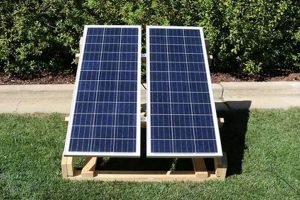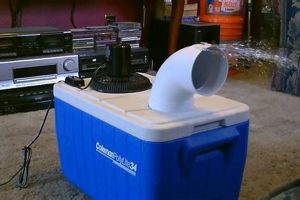A self-assembled mobile signal amplifier refers to equipment constructed from readily available materials with the intention of improving cellular reception. These are often attempted solutions designed to circumvent the cost or complexity associated with commercially available signal boosting systems. Examples include parabolic reflectors made from common household items, or modified antenna configurations utilizing basic electronic components.
The perceived need for improvised signal enhancement stems from inconsistent cellular coverage experienced in various locations. Individuals may seek to improve call quality, data speeds, or overall reliability of mobile devices. Historically, individuals have explored various methods to optimize radio wave reception, leading to the creation of numerous do-it-yourself approaches in the field of cellular communication.
The following sections will explore the principles behind signal amplification, common construction techniques employed in these projects, the limitations and potential risks associated with them, and the regulatory considerations that govern the use of such devices.
Considerations for Implementing Improvised Signal Enhancement
Before attempting to construct a solution for improving cellular signal reception, several crucial factors require careful assessment. Adherence to these considerations can mitigate potential risks and enhance the likelihood of achieving desired results.
Tip 1: Analyze Existing Signal Strength: Measure the existing cellular signal strength using the device’s built-in indicators or specialized applications. This provides a baseline for evaluating the effectiveness of any implemented modifications. Record signal strength in decibel-milliwatts (dBm) both indoors and outdoors.
Tip 2: Identify Primary Carrier Frequency: Determine the specific cellular frequencies utilized by the intended carrier in the area. This information is crucial for optimizing antenna design and reflector dimensions. Consult carrier documentation or use a spectrum analyzer application.
Tip 3: Optimize Antenna Placement: Experiment with the physical location of the receiving antenna or reflector. Even slight adjustments can significantly impact signal reception. Consider elevation, proximity to windows, and orientation relative to cell towers.
Tip 4: Utilize Appropriate Materials: Select materials with reflective properties suitable for radio frequency signals. Aluminum foil, metallic mesh, and specifically designed reflector sheets offer varying degrees of performance. Avoid materials that attenuate radio waves, such as wood or certain plastics.
Tip 5: Ensure Proper Grounding: Ground any metallic components of the system to prevent static buildup and potential electrical hazards. Proper grounding enhances signal clarity and protects connected devices from surges.
Tip 6: Implement Shielding Measures: Shielding surrounding electronic devices from the antenna can minimize interference. Employing grounded metal enclosures or conductive tape can reduce noise and improve signal-to-noise ratio.
Tip 7: Document All Modifications: Maintain a detailed record of all modifications made to the system, including materials used, dimensions, and antenna configurations. This documentation aids in troubleshooting and future optimization efforts.
Careful application of these considerations can increase the effectiveness of improvised solutions, while minimizing potential risks to equipment and compliance.
The following section will address the legal and regulatory landscape surrounding cellular signal amplification, emphasizing the importance of compliance.
1. Signal Strength Amplification
Signal strength amplification is the fundamental principle underlying the functionality of a do-it-yourself mobile signal amplifier. The purpose of such a device is to capture a weak cellular signal, boost its power, and rebroadcast the amplified signal to improve reception for nearby mobile devices. The effectiveness of any improvised signal enhancement method directly correlates with its ability to amplify the received signal without introducing excessive noise or distortion. For example, a poorly designed antenna may capture a signal, but its inability to efficiently amplify the signal within the appropriate frequency bands renders it ineffective.
The amplification process in homemade systems typically involves passive components, such as reflectors and specially shaped antennas, designed to focus incoming radio waves onto a receiving element. The stronger signal is then either directly coupled to a device, or re-transmitted. The limitations and the legalities of such are a huge consideration. Improper configuration or poor design can result in several issues, including interference with nearby base stations and the creation of dead zones due to phase cancellation. Real-world examples include individuals using repurposed satellite dishes as reflectors, which, while potentially increasing signal strength in a narrow area, can also negatively impact signal quality in surrounding areas. It is worth noting that many of these methods may not meet required standards or be legal in many locations.
In summary, signal strength amplification is integral to the success of a do-it-yourself mobile signal booster. Understanding the limitations of passive amplification techniques, the importance of frequency targeting, and the potential for interference is crucial for constructing a functional and compliant device. However, caution is paramount as improperly designed or implemented systems can degrade rather than improve signal quality and may violate regulations.
2. Antenna Design Principles
The effective functionality of a self-constructed mobile signal amplifier is inextricably linked to the application of established antenna design principles. An antenna, in this context, serves as the interface between the mobile device and the surrounding electromagnetic environment, responsible for capturing and radiating radio frequency signals. The design parameters of this antenna directly influence its ability to efficiently receive and transmit signals within the specific frequency bands utilized by cellular networks. Suboptimal antenna design can severely limit the effectiveness of the attempted enhancement, resulting in minimal to no improvement in signal strength, or even a degradation of existing signal quality. For instance, an antenna designed with an improper impedance match will reflect a significant portion of the incoming signal, reducing the amount of energy available for amplification and subsequent rebroadcasting. The proper selection of antenna type, such as a Yagi-Uda or a parabolic reflector, is determined by factors including gain, bandwidth, and directionality, each of which plays a crucial role in optimizing signal ca
pture and transmission.
The practical application of antenna design principles in this context extends to the consideration of antenna dimensions, element spacing, and material properties. For example, the length of a dipole antenna is directly proportional to the wavelength of the signal it is intended to receive or transmit. Deviations from this optimal length will result in reduced efficiency and diminished signal performance. Similarly, the proper selection of materials with appropriate conductivity and minimal signal loss is essential for maintaining signal integrity throughout the antenna structure. Practical implications include the use of copper or aluminum for antenna elements, and the avoidance of materials that exhibit high dielectric losses at cellular frequencies. Furthermore, polarization matching between the transmitting and receiving antennas is vital for maximizing signal transfer. Mismatched polarizations can lead to significant signal attenuation, undermining the effectiveness of the entire improvised system. Therefore, attention to antenna polarization ensures the received signal is appropriately aligned with the receiving antenna.
In summary, adherence to antenna design principles is a prerequisite for the successful construction of a mobile signal amplifier. Proper antenna design dictates efficiency, signal strength, and overall performance. Challenges in this area often arise from a lack of understanding of radio frequency engineering concepts and the complexities of electromagnetic wave propagation. Careful consideration of antenna type, dimensions, materials, and polarization is essential for achieving the desired enhancement in cellular signal reception. A disregard for these principles can result in a non-functional device or, potentially, interference with cellular networks, leading to regulatory consequences.
3. Frequency Band Compatibility
Achieving functional enhancement through self-assembled cellular signal amplification is critically contingent upon ensuring frequency band compatibility. Disregarding this fundamental aspect renders any attempt at signal boosting futile, as the system will be incapable of interacting effectively with the intended cellular network.
- Cellular Network Standards and Frequency Allocation
Cellular networks operate on specific frequency bands designated by regulatory bodies. These bands vary geographically and according to the cellular technology in use (e.g., GSM, UMTS, LTE, 5G). A device intended to amplify a cellular signal must be designed to operate within the frequency band allocated to the targeted network provider. For example, if a provider uses the 850 MHz and 1900 MHz bands for 3G services, an amplification system must be capable of capturing and re-broadcasting signals within these specific ranges to function correctly. Failure to align with these frequencies results in the device amplifying irrelevant radio waves or, worse, interfering with other legitimate communication channels.
- Antenna Resonance and Bandwidth
The antenna, a critical component of any signal amplification system, must exhibit resonance within the target frequency band. Antenna resonance refers to the antenna’s ability to efficiently capture and radiate electromagnetic energy at specific frequencies. The antenna’s bandwidth defines the range of frequencies over which it maintains acceptable performance. A narrow-band antenna, designed for a specific frequency, will perform poorly outside of that narrow range. Conversely, a broadband antenna offers wider coverage but may exhibit lower gain within the target band. A DIY amplifier utilizing an antenna not resonant with the cellular band of interest will show poor signal capture and amplification properties, which is akin to trying to capture water with a sieve.
- Filtering and Signal Purity
Cellular signals are often accompanied by extraneous radio frequency noise and signals from other sources. To ensure effective and reliable signal amplification, filtering is necessary to isolate the desired cellular signal from unwanted interference. Filters are electronic circuits designed to pass signals within a specific frequency range while attenuating signals outside that range. Inadequate filtering can result in the amplification of noise, which degrades the quality of the amplified signal and can interfere with cellular network operation. Poor filtering in a DIY amplifier could lead to amplifying TV signals or radio stations, creating more problems than solutions.
- Regulatory Compliance and Spectrum Usage
Operation within allocated frequency bands is not merely a technical requirement; it is a legal obligation. Regulatory bodies, such as the FCC in the United States, regulate the use of the radio frequency spectrum to prevent interference and ensure equitable access to communication channels. The use of a self-assembled amplification device operating outside designated frequencies or exceeding permitted power levels can result in significant fines and legal penalties. It is imperative that any signal amplification system complies with all applicable regulations regarding spectrum usage. For example, operating on frequencies reserved for public safety or emergency services is strictly prohibited and carries severe consequences.
The intersection of frequency band compatibility and the construction of “diy cell phone booster” underscores the necessity of a comprehensive understanding of radio frequency principles and regulatory frameworks. Attempting to enhance cellular signal strength without due consideration to these factors is not only unlikely to yield positive results but also carries the risk of legal repercussions and potential interference with critical communication systems. Therefore, thorough research and a commitment to adherence to established standards are paramount.
4. Material Reflectivity Properties
The effectiveness of a self-assembled mobile signal amplifier is directly influenced by the reflective properties of the materials utilized in its construction, particularly those intended to function as reflectors. Radio waves, like light, are reflected by conductive surfaces. The efficiency of this reflection determines the extent to which a reflector can focus and concentrate the existing signal onto the antenna. The underlying principle relies on redirecting weak signals from a broader area towards the antenna, effectively increasing the signal strength. For example, a parabolic reflector constructed from aluminum foil can focus radio waves onto an antenna positioned at its focal point. The degree of signal enhancement is proportional to the reflector’s surface area, its parabolic accuracy, and the reflectivity of the aluminum foil. A poor reflector will scatter the incoming waves, failing to concentrate them effectively and resulting in minimal signal gain. The improper material might even absorb signal strength instead of reflecting.
The choice of material significantly impacts the performance of the reflective component. Ideal materials exhibit high electrical conductivity and minimal signal loss at the frequencies utilized by cellular networks. Metals like aluminum, copper, and silver are common choices due to their high conductivity. However, practical considerations such as cost and ease of fabrication often lead to the selection of aluminum foil or coated cardboard. Th
e angle of incidence of the radio waves relative to the reflector’s surface also affects the reflection efficiency. Smooth, continuous surfaces reflect signals more predictably than rough or discontinuous surfaces. A real-world example is the difference between a smooth sheet of aluminum foil and crumpled foil; the smooth sheet will provide a more focused reflection. It is also critical to consider oxidation. The oxidation of a metallic reflector over time can decrease its conductivity and, consequently, its reflective efficiency.
In summary, the reflectivity of materials is a critical determinant of performance in a self-assembled mobile signal booster. High conductivity, smooth surfaces, and appropriate shaping are key attributes of effective reflectors. Selecting suboptimal materials or neglecting surface preparation can significantly diminish signal enhancement. While readily available materials may offer a cost-effective solution, careful consideration of their reflective properties is essential for achieving tangible improvements in cellular signal reception. It is important to note that even with optimal materials, regulatory compliance and potential interference with cellular networks remain critical considerations.
5. Regulatory Compliance Mandates
Adherence to regulatory compliance mandates is a critical, non-negotiable aspect of any attempt to construct a mobile signal amplifier. Failure to comply with these mandates can result in substantial penalties, legal repercussions, and potential interference with licensed communication systems. Therefore, a thorough understanding of the relevant regulations is paramount before undertaking any such project.
- Federal Communications Commission (FCC) Regulations
In the United States, the FCC governs the use of the radio frequency spectrum. Specifically, FCC Part 95 and Part 22 outline the rules and regulations pertaining to signal boosters and cellular devices. These regulations establish permissible power levels, frequency bands, and technical specifications that must be met to ensure compliance. A self-assembled device that exceeds power limits or operates outside designated frequencies violates these regulations, potentially interfering with licensed services. For example, a booster operating on frequencies reserved for emergency services could disrupt critical communications and incur significant fines.
- Spectrum Usage and Interference
Regulatory mandates are designed to prevent harmful interference to licensed radio services, including cellular networks, public safety communications, and aeronautical systems. Self-assembled boosters that are not properly designed or shielded can generate spurious emissions that interfere with these services. Such interference can degrade network performance, disrupt emergency communications, and pose safety risks. Therefore, compliance with emission limits and technical standards is essential to prevent such interference. For example, a poorly shielded booster could emit radio frequency energy that disrupts nearby television or radio reception.
- Device Certification and Authorization
Most jurisdictions require electronic devices that emit radio frequency energy to be certified or authorized by a regulatory agency before they can be legally sold or operated. This process involves testing and verification to ensure that the device meets applicable technical standards and does not cause harmful interference. Self-assembled boosters typically lack such certification, rendering their operation illegal in many areas. Attempting to circumvent this process by building and operating an uncertified device exposes the user to potential enforcement actions. For instance, marketing or selling a DIY booster without FCC certification would violate regulations.
- International Regulations
The regulatory landscape for signal boosters varies across different countries and regions. Each jurisdiction has its own set of rules and regulations governing the use of the radio frequency spectrum. A self-assembled booster that complies with FCC regulations in the United States may not necessarily comply with regulations in other countries. Therefore, it is crucial to research and understand the relevant regulations in the specific location where the booster is intended to be used. For example, some countries may have stricter limits on output power or require specific licensing for signal boosters.
The construction and operation of a “diy cell phone booster” are subject to stringent regulatory compliance mandates. Ignoring these mandates can have significant legal and operational consequences. Adherence to established technical standards, emission limits, and certification requirements is essential to ensure responsible and lawful use of the radio frequency spectrum. Therefore, prospective builders should thoroughly investigate and understand the relevant regulations before undertaking any such project, and should consider professionally manufactured and certified alternatives to avoid potential legal and technical issues.
6. Interference Mitigation Strategies
The effective operation of a self-constructed mobile signal amplifier necessitates the implementation of robust interference mitigation strategies. Due to the potential for these devices to generate unwanted signals or amplify existing noise, proactive measures are crucial to ensure minimal disruption to other electronic systems and compliance with regulatory standards. Ignoring these strategies can lead to degraded performance, regulatory penalties, and, in extreme cases, the complete inoperability of the system.
- Shielding and Grounding Techniques
Electromagnetic shielding and proper grounding are essential for minimizing the emission of spurious signals and reducing susceptibility to external interference. Shielding involves enclosing sensitive components within a conductive barrier to attenuate electromagnetic radiation. Grounding provides a low-impedance path for unwanted currents, preventing them from propagating through the system and causing interference. For example, enclosing the amplifier circuitry in a metal box and connecting it to a reliable ground can significantly reduce radiated emissions. Improper grounding, on the other hand, can create ground loops that amplify noise and increase susceptibility to interference.
- Filtering and Signal Conditioning
Filtering techniques are employed to selectively pass desired signals while attenuating unwanted frequencies and noise. Bandpass filters are used to isolate the cellular frequency bands of interest, rejecting out-of-band signals that could cause interference. Signal conditioning techniques, such as automatic gain control (AGC), help to maintain a stable signal level, preventing the amplifier from overdriving and generating distortion products. For instance, a filter designed to pass only the 850 MHz cellular band can block interfering signals from nearby FM radio stations. Without proper filtering, the amplifier may amplify noise and other unwanted signals, degrading the overall signal quality.
- Antenna Placement and Orientation
The placement and orientation of the antennas used in the system can significantly impact the level of interference generated or received. Optimizing antenna plac
ement to minimize coupling with other electronic devices and orienting the antennas to reduce directivity towards potential sources of interference can help to mitigate these issues. For example, positioning the amplifier’s external antenna away from Wi-Fi routers or other wireless devices can reduce the potential for interference. Conversely, placing the antennas too close together can result in signal feedback and instability. - Regulatory Compliance and Testing
Compliance with regulatory mandates, such as those established by the FCC, requires adherence to specific emission limits and technical standards. Thorough testing of the completed amplifier is essential to verify that it meets these standards and does not cause harmful interference. This testing may involve measuring radiated emissions, conducted emissions, and signal distortion levels. Failure to comply with these regulations can result in significant fines and legal penalties. For instance, testing a DIY booster with a spectrum analyzer to verify compliance with FCC emission limits is an essential step.
Effective interference mitigation strategies are an indispensable aspect of constructing a functional and compliant self-assembled mobile signal booster. By implementing appropriate shielding, filtering, antenna placement, and testing procedures, potential builders can minimize the risk of interference, ensure optimal performance, and avoid regulatory consequences. A disregard for these strategies can render the amplifier ineffective or even detrimental to the surrounding electromagnetic environment, highlighting the importance of a meticulous and conscientious approach.
7. Device Security Vulnerabilities
Self-assembled mobile signal amplifiers, while intended to improve cellular reception, introduce potential device security vulnerabilities. These vulnerabilities stem from the modifications and configurations inherent in DIY construction, circumventing the rigorous security testing and protocols applied to commercially manufactured devices. Compromised components, altered firmware (if applicable), or the introduction of unvetted hardware interfaces can create pathways for malicious actors to exploit device functions or intercept transmitted data. For example, a poorly secured amplifier could be manipulated to act as a rogue base station, capturing mobile identification data or routing communications through unencrypted channels. Furthermore, the lack of security updates and patches, common in commercial devices, leaves such homemade solutions permanently susceptible to known exploits. This absence of ongoing security maintenance makes such devices enticing targets for those seeking to compromise network security.
The absence of standardized security protocols in DIY designs amplifies the risk. Commercial boosters undergo thorough security audits to identify and mitigate potential weaknesses. These include measures to prevent unauthorized access, signal manipulation, and data interception. The self-constructed device, lacking these security features, may inadvertently expose user data and communications to eavesdropping or manipulation. Consider a scenario where a DIY booster, designed with insufficient signal isolation, leaks sensitive data into neighboring networks. This could allow unauthorized parties to intercept phone calls, text messages, or even access financial information. The practical significance of understanding these vulnerabilities lies in the recognition that improved signal strength should not come at the expense of security. Users must weigh the benefits of improved reception against the potential risks to their personal data and network security.
In summary, device security vulnerabilities represent a significant challenge associated with DIY mobile signal amplifiers. The absence of security testing, standardized protocols, and ongoing maintenance creates opportunities for malicious exploitation. Understanding these risks is crucial for making informed decisions about the construction and deployment of such devices. While the allure of improved signal strength may be strong, users must acknowledge the potential security implications and consider the potential compromise of sensitive data. Therefore, a balanced assessment is necessary, weighing the benefits of improved reception against the inherent security risks, and considering professional alternatives.
Frequently Asked Questions
The following section addresses common inquiries regarding the construction and utilization of do-it-yourself (DIY) mobile signal amplification solutions. It aims to clarify misconceptions and provide factual information.
Question 1: Is constructing a mobile signal booster a viable solution for improving cellular reception?
The viability of a DIY approach depends significantly on the knowledge and skill of the individual, the availability of appropriate materials, and a thorough understanding of regulatory constraints. While theoretically possible, a properly designed and compliant commercial product typically offers a more reliable and legally sound solution.
Question 2: What are the potential risks associated with operating a self-assembled signal amplifier?
Risks include interference with licensed radio communications, violation of federal regulations, potential damage to cellular network infrastructure, and compromise of device security. Improperly designed or operated amplifiers can disrupt critical communication channels and incur significant legal penalties.
Question 3: Does the size of the reflector directly correlate with signal amplification effectiveness?
While a larger reflector surface area can capture more signal, effectiveness also depends on the accuracy of the reflector’s shape, the material’s reflective properties, and the proper placement of the antenna. Simply increasing size without optimizing these factors may not yield substantial improvement.
Question 4: Are there specific materials that are strictly prohibited for use in signal amplification devices?
Materials that significantly attenuate radio waves, such as wood or certain plastics, are unsuitable. Furthermore, using components salvaged from devices restricted by regulatory bodies, or incorporating active amplification without proper licensing is prohibited.
Question 5: How does frequency band compatibility affect the functionality of a self-assembled booster?
Frequency band compatibility is paramount. The amplifier and antenna must be designed to operate within the specific frequency bands utilized by the targeted cellular network. Mismatched frequencies render the device ineffective, potentially amplifying noise or interfering with other services.
Question 6: What steps are essential to ensure regulatory compliance when experimenting with signal amplification?
Thorough research of FCC regulations (or the relevant governing body in the applicable region) is essential. Operation must adhere to permissible power levels, frequency bands, and emission limits. Testing and verification with appropriate equipment are necessary to ensure compliance and prevent interference.
In summary, constructing a signal amplifier presents numerous technical and regulatory challenges. A comprehensive understanding of radio frequency principles, regulatory mandates, and safety considerations is crucial for responsible experimentation. Consider that professional guidance is advisable prior to proceeding.
The subsequent section will explore commercially available alternative
s to DIY signal boosters, outlining their benefits and limitations.
Conclusion
This exploration of the self-assembled mobile signal amplifier reveals the complexities inherent in attempting to enhance cellular reception through non-commercial means. Significant technical knowledge, adherence to stringent regulatory guidelines, and a careful assessment of potential security vulnerabilities are required for responsible experimentation. The pursuit of improved signal strength necessitates a thorough understanding of radio frequency principles, materials science, and the legal ramifications of operating such devices.
Given the inherent challenges and potential risks, individuals should exercise caution and carefully weigh the benefits against the potential liabilities. While the concept of creating signal enhancement solutions is appealing, professionally engineered and certified options offer a more reliable and legally compliant path to improved cellular connectivity. Prioritize responsible spectrum usage and adherence to established regulations to avoid unintended consequences and legal ramifications. The integrity of cellular communication infrastructure depends on the adherence to established protocols.







